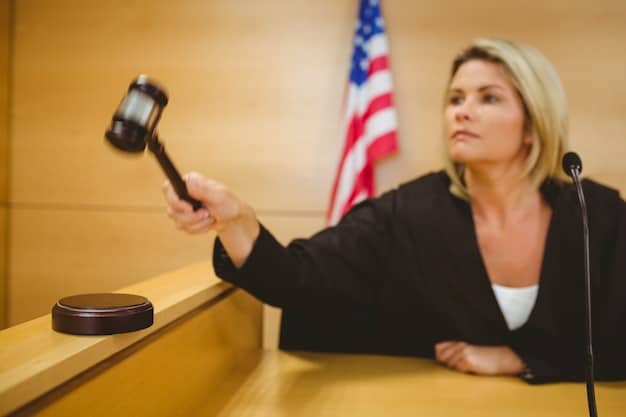Counterfeit Goods Surge: Legal Recourse for US E-commerce Sellers

Counterfeit goods on e-commerce platforms have risen by 15%, posing significant challenges for US sellers; the latest legal recourse includes DMCA takedown notices, trademark infringement lawsuits, and utilizing platform-specific anti-counterfeiting programs to protect intellectual property and brand reputation.
The e-commerce landscape is increasingly threatened by the proliferation of counterfeit goods, with a recent surge of 15% putting immense pressure on legitimate US sellers. Understanding the available legal recourse is now more critical than ever to protect your brand and intellectual property. This article delves into the latest strategies and legal options for tackling this growing issue, ensuring your business can thrive in a competitive market. Urgent Alert: Counterfeit Goods on E-commerce Platforms Rise by 15% – What’s the Latest Legal Recourse for US Sellers?. Keep reading to learn more!
Understanding the Rising Tide of Counterfeit Goods
The rise of e-commerce has unfortunately been accompanied by a corresponding increase in counterfeit products. This section introduces the scope of the problem and its impact on US sellers.
Counterfeit goods pose a significant threat to the integrity of the e-commerce ecosystem and the livelihoods of countless legitimate businesses.
Factors Contributing to the Increase
Several factors contribute to the increasing prevalence of counterfeit goods on e-commerce platforms. Globalization has made it easier for counterfeiters to manufacture and distribute fake products, while the anonymity afforded by online marketplaces allows them to operate with impunity.
- Globalization facilitates sourcing and distribution of counterfeit products.
- Anonymity online allows counterfeiters to hide their identities.
- Consumer demand for cheaper alternatives unwittingly fuels the market.
- Inadequate platform oversight enables counterfeiters to thrive.
Increased technology, which has enabled better printing and distribution, has also helped counterfeiters to better mimic the original product.
The economic impact on genuine businesses is substantial, resulting in loss of revenue, damage to brand reputation and trust, and increased legal and enforcement costs.

In response, businesses must implement comprehensive strategies to protect their brands and intellectual property. This includes proactively monitoring online marketplaces, registering trademarks and copyrights, and taking swift legal action against counterfeiters.
The Digital Millennium Copyright Act (DMCA) Takedown Notices
The DMCA provides a legal framework for removing infringing content from online platforms. This section details how US sellers can utilize DMCA takedown notices to combat counterfeiting. The DMCA is a cornerstone in the legal fight against digital copyright infringement.
A DMCA takedown notice is a formal request to an online service provider to remove content that infringes on a copyright. It’s a tool that rights holders can use to protect their copyrighted works from being illegally copied and distributed online.
How to File a DMCA Takedown Notice
Filing a DMCA takedown notice involves several critical steps. First, identify the infringing content and determine the copyright owner. Then, draft a notice that complies with DMCA requirements, including a statement of good faith belief that the content infringes the copyright and a declaration under penalty of perjury that the information provided is accurate. Finally, send the notice to the designated agent of the online service provider.
- Identify the infringing content and its location.
- Draft a notice complying with DMCA requirements.
- Include a statement of good faith and accuracy.
- Send the notice to the online service provider’s designated agent.
Effectively utilizing DMCA takedown notices can help to swiftly remove counterfeit listings from e-commerce platforms, reducing the potential for customer confusion and protecting your brand’s revenue streams.
The DMCA Safe Harbor provisions protect online service providers from liability for copyright infringement by their users, provided they comply with certain requirements, including promptly removing infringing content upon receiving a valid DMCA takedown notice.
Trademark Infringement Lawsuits: A Strong Legal Stance
Trademark infringement lawsuits provide a powerful legal tool for US sellers to protect their brand and prevent the sale of counterfeit goods. This section explains the process and benefits of pursuing legal action. Protecting your trademark is essential in the fight against counterfeiting.
A trademark infringement lawsuit is a legal action brought by a trademark owner against someone who is using their trademark without permission, in a way that is likely to cause confusion among consumers.

Steps to Filing a Trademark Lawsuit
Filing a trademark infringement lawsuit involves several key steps. First, conduct a thorough investigation to gather evidence of infringement. Then, file a complaint with the appropriate court, outlining the alleged infringement and the relief sought. Next, serve the complaint on the defendant and engage in discovery to gather additional evidence. Finally, proceed to trial or settlement negotiations to resolve the dispute.
- Conduct a thorough investigation of the infringement.
- File a complaint with the appropriate court.
- Serve the complaint on the defendant.
- Engage in discovery to gather evidence.
The legal remedies available in a trademark infringement lawsuit include injunctive relief, monetary damages, and attorney’s fees. Injunctive relief can prevent the defendant from continuing to infringe on the trademark, while monetary damages can compensate the trademark owner for the harm suffered as a result of the infringement.
Successful trademark infringement lawsuits can serve as a powerful deterrent to counterfeiters, protecting your brand’s reputation and deterring future violations.
Platform-Specific Anti-Counterfeiting Programs
Many e-commerce platforms offer anti-counterfeiting programs designed to help sellers protect their intellectual property. This section outlines the features and benefits of these programs. Participating in these programs can significantly reduce the risk of counterfeit goods being sold.
Platform-specific anti-counterfeiting programs are initiatives offered by e-commerce platforms to help sellers protect their intellectual property rights, such as trademarks and copyrights, and combat the sale of counterfeit goods on their platforms.
Examples of Anti-Counterfeiting Programs
Examples of anti-counterfeiting programs include Amazon’s Brand Registry, eBay’s Verified Rights Owner (VeRO) Program, and Alibaba’s Intellectual Property Rights (IPR) Protection Platform. These programs typically provide sellers with tools and resources to monitor listings, report infringements.
These programs offer sellers enhanced control over their brand presence on the platform, enabling them to quickly identify and remove counterfeit listings, and receive priority support.
By leveraging these programs, sellers can proactively protect their brands and maintain customer trust. This involves enrolling in the relevant programs, using provided tools and resources to actively monitor listings, and promptly reporting any identified infringements.
Monitoring and Enforcement Strategies
Proactive monitoring and enforcement are essential for combating the sale of counterfeit goods on e-commerce platforms. This section details proven strategies for detecting and addressing counterfeit listings. It is important to stay vigilant and proactive in your efforts to combat counterfeiting.
Monitoring and enforcement strategies are proactive measures taken by brand owners to detect and address the sale of counterfeit goods on e-commerce platforms, including automated monitoring tools, test purchases, and collaboration with law enforcement.
Effective Monitoring Techniques
Effective monitoring techniques involve using automated tools to scan listings for trademark or copyright infringements, conducting regular test purchases to verify the authenticity of products, and tracking customer reviews and feedback to identify potential counterfeit goods.
- Use automated tools to scan for infringements.
- Conduct regular test purchases to verify authenticity.
- Track customer reviews and feedback.
- Implement robust data analytics to identify patterns.
Swift enforcement actions, such as sending cease and desist letters, filing DMCA takedown notices, and pursuing legal action, can effectively remove counterfeit listings and deter future infringements.
Collaboration with law enforcement agencies, such as the U.S. Customs and Border Protection (CBP) and the Federal Bureau of Investigation (FBI), can also help to disrupt counterfeit supply chains and bring counterfeiters to justice.
Preventative Measures for E-commerce Sellers
In addition to reactive measures, implementing preventative measures can significantly reduce the risk of counterfeit goods being sold in the first place. This section outlines steps sellers can take to protect their brands. Prevention is the best defense against counterfeiting.
Preventative measures are proactive steps taken by brand owners to reduce the risk of counterfeit goods being sold on e-commerce platforms, including registering intellectual property, implementing product authentication measures, and educating consumers.
Steps to Protect Your Brand
Steps to protect your brand include registering trademarks and copyrights, implementing product authentication measures such as holograms or QR codes, educating consumers about how to identify genuine products, and working with e-commerce platforms to implement stricter anti-counterfeiting policies.
- Register trademarks and copyrights to protect intellectual property.
- Implement product authentication measures like holograms.
- Educate consumers on identifying genuine products.
- Collaborate with platforms for stricter policies.
Regularly auditing supply chains can help identify and eliminate potential sources of counterfeit goods. This involves conducting thorough due diligence on suppliers, implementing quality control measures, and monitoring production processes.
Creating strong partnerships with authorized distributors and retailers can help ensure that genuine products are reaching consumers through legitimate channels.
| Key Point | Brief Description |
|---|---|
| 🛡️ DMCA Takedown | Remove infringing content legally with a takedown notice. |
| ⚖️ Trademark Suits | File lawsuits for trademark infringement to protect your brand. |
| ✔️ Platform Programs | Use anti-counterfeiting programs provided by platforms. |
| 👀 Monitoring Tools | Continuously monitor online listings for counterfeit products. |
Frequently Asked Questions (FAQ)
▼
A DMCA takedown notice is a legal request to an online service provider to remove material that infringes on a copyright. It’s a key tool for protecting copyrighted content from unauthorized distribution online.
▼
Look for listings with unusually low prices, poor product images, and vague descriptions. Check seller ratings and reviews for suspicious patterns. Purchase test products to verify their authenticity.
▼
Examples include Amazon’s Brand Registry and eBay’s Verified Rights Owner (VeRO) Program. These programs offer tools for reporting and removing infringing listings quickly and efficiently.
▼
Legal remedies include injunctive relief (stopping the infringer), monetary damages (compensation for losses), and attorney’s fees. The specifics can vary based on the severity and extent of the infringement.
▼
Register your trademarks and copyrights, implement product authentication measures (like holograms), educate consumers about genuine products, and monitor your supply chain for vulnerabilities to minimize counterfeiting.
Conclusion
In conclusion, the rise of counterfeit goods on e-commerce platforms presents a serious challenge to US sellers. By understanding and utilizing the latest legal recourse, including DMCA takedown notices, trademark infringement lawsuits, and platform-specific anti-counterfeiting programs, sellers can protect their intellectual property, brand reputation, and bottom line. Proactive monitoring, enforcement, and preventative measures are crucial for success in this ongoing battle.





